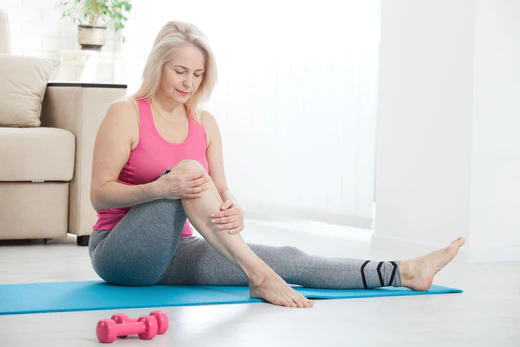Do you ever find yourself struggling with persistent pain that seems to cloud your days and nights? If so, you’re not alone. Chronic pain can be like an unwelcome companion, affecting every aspect of your life. But here’s the good news – there are practical, accessible ways to break free from the grip of pain and rediscover a life filled with comfort and vitality. In this article, we’ll explore some simple yet powerful practices that can be your helpers on the journey to pain liberation.
Have you ever wondered if there’s more to life than persistent discomfort day in and day out? Are you ready to take steps towards a brighter, pain-free future? Well, you’re in the right place. Let’s explore some of the ancient ayurvedic techniques that can improve your well-being, both physically and mentally, while helping you say goodbye to persistent pain.
Abhyanga (Full body massage)

Abhyanga, an integral part of Ayurvedic practice, is a soothing massage technique where warm oil is gently applied to the body. This ancient therapy offers a range of benefits for physical and mental health. The warm oil used in Abhyanga helps improve blood circulation, enhancing the flow of oxygen and nutrients throughout the body. It also aids in reducing muscle tension, making it an excellent choice for those with sore or stiff muscles. The gentle strokes and kneading motions during the massage provide a deep sense of relaxation, calming the mind and relieving stress.
Yoga and Exercise

Yoga and exercise, particularly gentle yoga and stretching routines, can be powerful tools for pain relief. These practices focus on improving flexibility, strengthening muscles, and enhancing body awareness, which can alleviate various types of pain, including muscle tension, chronic pain conditions, and stress-related discomfort.
Yoga, with its origins in ancient India, encompasses a wide range of practices that promote physical and mental health. Gentle yoga, in particular, emphasizes slow and controlled movements, deep breathing, and relaxation techniques. These elements work synergistically to release muscle tension and reduce pain. The gentle stretches in yoga help improve flexibility and range of motion, which is especially beneficial for individuals suffering from musculoskeletal pain, such as back pain or arthritis. The controlled breathing techniques employed in yoga can also activate the body’s relaxation response, reducing stress and promoting pain relief.
Regular exercise, including low-impact aerobic activities like walking or swimming, can also play a crucial role in pain liberation. Exercise increases blood flow, which helps to deliver oxygen and nutrients to muscles, aiding in their repair and reducing soreness. Moreover, exercise triggers the release of endorphins, the body’s natural painkillers, which can provide a sense of well-being and pain relief.
Combining yoga and exercise can be particularly effective for managing chronic pain conditions. For example, individuals with fibromyalgia may find relief through gentle yoga, which can help improve sleep quality and reduce pain sensitivity. Additionally, engaging in strength-building exercises can stabilize joints and alleviate pain associated with conditions like osteoarthritis.
Rest and Sleep
Adequate rest and sleep are essential components of overall health, with profound benefits for pain management. Insufficient sleep not only worsens existing pain but also impairs the body’s natural healing mechanisms, making it vital to prioritize restful sleep.
When we sleep, our bodies engage in vital processes such as tissue repair, immune system strengthening, and the release of growth hormones. Inadequate sleep disrupts these functions, leading to increased pain sensitivity and reduced pain tolerance. Chronic pain conditions, such as fibromyalgia and chronic fatigue syndrome, are particularly susceptible to worsening when sleep is compromised.
Maintaining a regular sleep schedule is key to reaping the pain liberation benefits. This consistency helps regulate circadian rhythms, optimizing the body’s internal clock for restful sleep. Additionally, establishing a calming bedtime routine signals to the body that it’s time to unwind, promoting relaxation and stress reduction. This, in turn, helps alleviate pain-related tension and anxiety, making it easier to fall asleep and stay asleep throughout the night.
Ayurvedic Herbs for Pain Relief
Ayurveda, an ancient healing system, values certain herbs for their ability to relieve pain effectively. Here are some standout herbs:
Turmeric: This spice contains curcumin, which fights inflammation, making it helpful for conditions like arthritis and muscle pain.
Ginger: Ginger has anti-inflammatory and pain-relieving effects, which can alleviate various types of discomfort.
Castor Oil: Castor oil contains ricinoleic acid, which has anti-inflammatory properties. Inflammation is often a source of pain, and reducing it can alleviate discomfort.
Frankincense: Specifically, the resin extracted from the Boswellia tree contains compounds with anti-inflammatory properties. These compounds can help reduce inflammation, which is often a root cause of pain in conditions like osteoarthritis and rheumatoid arthritis. But, incorporating all these herbs together in diet is a little challenging… Right? Worry not we have the perfect formulation of all these herbs in our tincture Nirvana (pain relief formulation) available at Oriaum.
These herbs don’t just mask the pain but target its underlying causes. They promote balance in the body and mind, reducing pain occurrence and severity. Embracing these natural remedies from Ayurveda is a gentle way to manage pain while enhancing overall health and vitality.
Patience and Persistence
Managing chronic pain is like a long race, not a quick sprint. You need patience and determination. When you’re dealing with ongoing pain, be kind to yourself. Progress can be slow, but don’t get frustrated. Healing takes time. Being consistent is your friend here. Doing pain relief exercises or therapies regularly may not show big changes right away, but they add up over time, like bricks building a fortress against pain. Celebrate small wins; they lead to a better, pain-free future. Stay strong on this journey; it’s worth it!
Conclusion:
In conclusion, achieving pain liberation is possible through a combination of practices and lifestyle choices. Abhyanga, yoga, exercise, restful sleep, and Ayurvedic herbs can all contribute to a pain-free life. Remember that chronic pain management is highly individualized, and what works for one person may not work for another. Always consult with healthcare professionals who can provide guidance tailored to your specific situation and needs.
Take the first step toward pain liberation by incorporating some of these practices into your daily routine. Whether it’s a gentle yoga session, a massage, or trying Ayurvedic herbs, you have the power to take control of your pain and improve your quality of life.





CeR9Exh8y0x
gbHj9D4PQ5v
eno0B3sDsGG
PyMUowZ9MNE
IDw0cmVrCxS
g3kFX8wAOcZ
PHdB2KW5NXN
0Mm5G9EZ4nb
GxEat9QKg3P
ETdpjUipaJ6
HFvmcCGoO1R
F4lzoXBn8rS
Bs9SOyU1CS3
T857oH9GUNY
2nbflXrzivL
SVur0LcEdKJ
ScdesB3j1Xe
9jtIN4tyqOj
BhgYX9zScRb
lCBaqBuZI3s
f8cG1Xfgdhz
gHdlCqhBFmc
4HONCZLGHbd
LY1QWVmN7ao
WLBG8ty29sK
m5vzDo3OSk6
2MmMhWPCFLB
YnCRQg0LbSs
xcoD4f1j2s2
Q1pmAKaQ0Rq
d3pZgdxO7WO
DMOCVzLaS98
luSAsqC6EGD
LAnVKiqZ2i9
HQikoRZbcHS